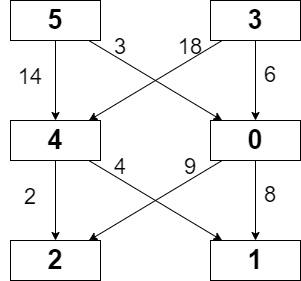Baozi Training Leetcode solution 2304. Minimum Path Cost in a Grid
作者:互联网
Problem Statement
You are given a 0-indexed m x n integer matrix grid consisting of distinct integers from 0 to m * n - 1. You can move in this matrix from a cell to any other cell in the next row. That is, if you are in cell (x, y) such that x < m - 1, you can move to any of the cells (x + 1, 0), (x + 1, 1), ..., (x + 1, n - 1). Note that it is not possible to move from cells in the last row.
Each possible move has a cost given by a 0-indexed 2D array moveCost of size (m * n) x n, where moveCost[i][j] is the cost of moving from a cell with value i to a cell in column j of the next row. The cost of moving from cells in the last row of grid can be ignored.
The cost of a path in grid is the sum of all values of cells visited plus the sum of costs of all the moves made. Return the minimum cost of a path that starts from any cell in the first row and ends at any cell in the last row.
Example 1:

Input: grid = [[5,3],[4,0],[2,1]], moveCost = [[9,8],[1,5],[10,12],[18,6],[2,4],[14,3]] Output: 17 Explanation: The path with the minimum possible cost is the path 5 -> 0 -> 1. - The sum of the values of cells visited is 5 + 0 + 1 = 6. - The cost of moving from 5 to 0 is 3. - The cost of moving from 0 to 1 is 8. So the total cost of the path is 6 + 3 + 8 = 17.
Example 2:
Input: grid = [[5,1,2],[4,0,3]], moveCost = [[12,10,15],[20,23,8],[21,7,1],[8,1,13],[9,10,25],[5,3,2]] Output: 6 Explanation: The path with the minimum possible cost is the path 2 -> 3. - The sum of the values of cells visited is 2 + 3 = 5. - The cost of moving from 2 to 3 is 1. So the total cost of this path is 5 + 1 = 6.
Constraints:
m == grid.lengthn == grid[i].length2 <= m, n <= 50gridconsists of distinct integers from0tom * n - 1.moveCost.length == m * nmoveCost[i].length == n1 <= moveCost[i][j] <= 100
Video Tutorial
You can find the detailed video tutorial hereThought Process
A classic DP problem (Dynamic Programming) because it's either ask you a boolean yes or no questions, Or ask for extreme values, e.g., min, max- Build up a minCost 2 day array, each array element denotes by far the min cost to reach to that element
- Make sure to initialize the values.


Solutions
1 public int minPathCost(int[][] grid, int[][] moveCost) {
2 if (grid == null || grid.length == 0 || grid[0] == null || grid[0].length == 0 || moveCost == null) {
3 return -1; // or throw exception
4 }
5
6 int[][] minCost = new int[grid.length][grid[0].length];
7 for (int i = 0; i < minCost[0].length; i++) {
8 minCost[0][i] = grid[0][i]; // first row costs are the init values
9 }
10
11 for (int i = 1; i < minCost.length; i++) {
12 for (int j = 0; j < minCost[0].length; j++) {
13 int min = Integer.MAX_VALUE;
14 for (int k = 0; k < minCost[0].length; k++) {
15 min = Math.min(min, minCost[i - 1][k] + moveCost[grid[i - 1][k]][j]);
16 }
17 minCost[i][j] = grid[i][j] + min;
18 }
19 }
20 int finalMin = Integer.MAX_VALUE;
21
22 for (int i = 0; i < minCost[0].length; i++) {
23 finalMin = Math.min(minCost[minCost.length - 1][i], finalMin);
24 }
25 return finalMin;
26 }
Time Complexity: O(N^3) since going through the 2-d array and another nested loop
Space Complexity: O(N^2) used the 2-d minCost array
References
- None
标签:Training,int,minCost,2304,solution,moveCost,length,cost,grid 来源: https://www.cnblogs.com/baozitraining/p/16410625.html